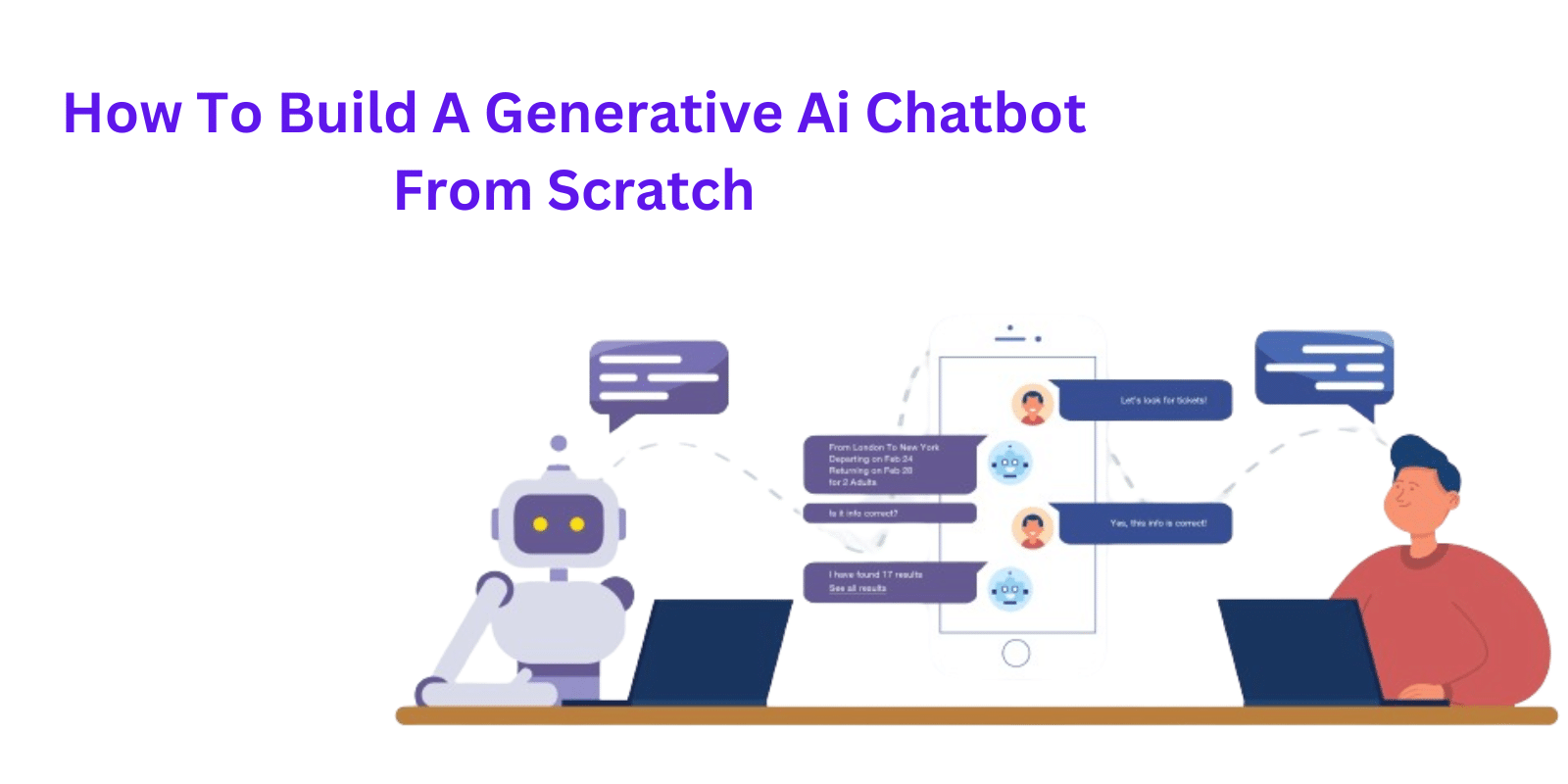How To Build A Generative AI Chatbot From Scratch
In our fast-paced society, where time is scarce, text messages have become among the top-used methods of communication. Therefore, chatbots have become an integral part of companies’ operations, regardless of the size of their business or area.
Knowing chatbots’ essential characteristics is necessary amid all the buzz about them. What exactly is a chatbot? Generative AI Chatbot are computer software designed to imitate human interaction. They produce automatized responses and engage with users, usually using voice or text inputs. They’re designed to perform various duties, from responding to commonly asked questions to providing customers with support to automating sales or marketing processes. These modules can be integrated into multiple platforms, including websites, social media channels, and messaging apps.
Companies use virtual assistants for routine tasks within business-to-business (B2B) and business-to-consumer (B2C) instances. Chatbots enable businesses to offer customer service even when live representatives aren’t around red, reduce overhead costs, and use staff time more efficiently. As per the Demand Sage report cited above, the average customer service representative handles 17 conversations daily, so implementing chatbots into companies can reduce the need for 2.5 billion work hours.
Chatbots are one of the most valuable and well-known applications of artificial intelligence, and they are becoming more widely used across different sectors. Follow this beginner’s tutorial on chatbot development to create your first intelligent AI chatbot. Generative AI chatbots, which produce reactions similar to real-life responses to user input, further enhance the process. This is the right spot if you’re eager to learn more about the latest technology and develop your very own dynamic AI chatbot.
Let’s explore chatbots in greater detail and learn more about the types of chatbots, their key elements, and their benefits. Here’s a complete guide to how to construct the first one.
A Brief Overview Of The Ai Chatbot
Chatbots are no longer a buzzword, especially today, as everyone is using ChatGPT. AI chat is an AI chatbot software that uses AI, other technological advances, and data sources to give human-like user responses. Chatbots are designed to read users’ natural language questions and generate relevant responses. AI chatbots can be used in different domains and application areas, such as information search and retrieval, customer service, virtual assistants, and more.
An AI chatbot is a program capable of analyzing, understanding, and responding to the human voice in a broader setting. It employs machine learning, natural language processing (NLP), and AI algorithms to communicate with humans. AI chatbots are trained using massive databases and can store information gained from conversations to help them in future training. AI chatbots, like ChatGPT, are highly effective software applications that continually grow when used.
These programs allow companies to provide a unique experience for every user. Instead of prompting users to pick predefined options, advanced AI-powered chatbots will answer any questions asked during normal conversation.
A few of the most impressive examples of AI-based chatbots include Slush, Cortana, Siri, and others. Advanced chatbots include ChatGPT, Google Bard, Jasper, and many more.
Types Of Chatbots
Chatbots can be classified in many ways depending on the parameters. These are the most common chatbot categories developed by AI Chatbot Development Company.
Rule Based Chatbots
Chatbots that operate according to a specific rulebook or script are referred to as rule-based chatbots. They provide predetermined responses to phrases or patterns discovered in user inputs. They are easy to use but limited in their functionality since they can only answer an enumeration of predefined queries.
Chatbots That Use Machine Learning
Artificial intelligence (AI) and natural language processing (NLP) methods are employed in machine-learning chatbots that recognize and respond to user input. Based on the user’s interactions, they can improve their response as they gain data. Chatbots based on machine learning are much more advanced and better at answering various issues than rules-based chatbots.
Retrieval-Based Chatbots
Chatbots based on retrieval produce responses using predefined responses stored in their database. They don’t create new replies but instead select the appropriate solution based on users’ input. Chatbots based on retrieval are often used to perform specific tasks or in domains in which predefined responses can be used.
Generative Chatbots
Chatbots that generate responses themselves instead of relying on already-defined responses are called Generative chatbots. They can create new, dynamic responses upon input from users. Unlike retrieval-based chatbots, generative chatbots’ replies are more flexible and imaginative. However, they may also be more challenging to construct and learn.
Chatbots designed for specific tasks, such as making appointments, providing customer assistance, or reserving rooms and reservations, are called task-oriented chatbots. They are limited in their operation scope and focused on executing a particular job.
Conversational Chatbots
Bots designed to allow for open-ended interaction with people are referred to as conversational chatbots. They aren’t necessarily given specific roles or duties, as they’re mostly involved in facilitating interactions with users. Conversational chatbots can be used to entertain customers, increase engagement, and create social connections.
Steps To Build Your Own AI Chatbot
It’s time to get serious. Let’s see how to develop your own chatbot with the help of Chatbot Development Services.
Define Your Use Case
AI chatbots can serve several functions. Are you developing a chatbot to help the customer service team? Are you planning to use chatbots to increase sales for your online stores? These questions can provide guidance and clarity in developing your chatbot strategy.
Some businesses will require the help of an AI chatbot for more than an easy FAQ. For example, you might want to use a chatbot to increase sales by learning customers’ needs and offering appropriate items. In these cases, it is necessary to combine different technologies.
Choose An Appropriate Tech Stack
If your objective is restricted to answering simple questions, making a customized chatbot commercially available using AWS, IBM, or Microsoft will suffice. Chatbots from these companies are relatively easy to create and deploy across various channels, such as social media sites and standalone applications. Alternatively, you could develop using low-level machine-learning libraries if you require features unavailable in traditional chatbot engines.
Design The Chatbot Conversation
Create the conversation flow for your chatbot. If you’re developing a straightforward chatbot, set up the decision tree to include the actions and messages users can interact with. However, the chatbot needs to be trained to comprehend the user’s intent and allow it to take the lead.
In other words, a rules-based chatbot cannot react to something it wasn’t designed to, but an AI-powered chatbot could. To build a chatbot capable of generating human-like responses, it is necessary to choose an initial model and then create instructions to generate an appropriate response. The bot then teaches itself about the expected results and stores the lessons for future use.
Build A Knowledgebase For The Chatbot
Don’t bother if you’re building an accessible, rule-based chatbot. If not, you can integrate your AI chatbot into knowledge bases to allow continual refinement of the environment the bot was built to serve. Knowledge bases store FAQs, chat histories, and other details that help the chatbot better comprehend users’ needs. This, in turn, allows the chatbot to become a better customer support agent.
Integrate The Chatbot With The App
The next step is to incorporate and verify its capabilities in the application for which it was created. It’s essential to design a strong UX/UI flow that allows you to seamlessly integrate the chatbot into a brand application that is new or already in use. Additionally, it’s essential to improve the data flow, ensure security, and monitor both the front-end and software.
Refine The Chatbot
Try the chatbot out using a pre-selected user group. Get feedback from users and refine chatbots or the deep-learning model of language. Ensure that the chatbot responds precisely as you expect and that having conversations with a human is feasible. When you’re happy, release the AI chatbot on the internet.
Best Practices In Deploying & Managing Your Chatbot
You’ve decided to develop your personal AI chatbot with the help of Chatbot Developer. You’ve got everything set and in place. How do you guarantee the long-term viability of your bot? The proper implementation and continual monitoring are just as crucial as the original idea. We’ll help you learn some top methods.
Ensuring Seamless User Experiences
# Making an AI chatbot doesn’t simply mean formulating intelligent responses. It’s about ensuring each user is completely content. Here are a few tips to help:
# It is essential to ensure that the users understand that they are communicating with a chatbot. Establishing clear expectations from the beginning can help avoid disappointment.
# Customers love the speed. Improve your chatbot’s performance to offer immediate or close-to-real-time answers. It will ensure that users feel they’re using their time effectively, improving overall user satisfaction.
# There isn’t always a perfect answer. Set up your chatbot with an approach for those times when it isn’t sure of the answer. It could direct users to a human or offer to look up additional information. Make sure that the users don’t get left hanging.
# Make the experience as personal as possible. Recalling previous interactions or using the user’s name can create a more personal experience.
Keeping Your Chatbot Relevant and Efficient
While you create your very own AI chatbot, keep in mind that it’s not finished when it’s launched:
# Establish mechanisms that permit users to offer feedback on every interaction. This feedback is real-time.
# When your company expands and grows, so does the chatbot you use. Therefore, you should constantly update your chatbot to reflect new product offerings or modifications to the business plan.
# Utilizing the information you’ve collected regularly, you can train your chatbot to understand new queries, terms of slang, or terms people could discuss.
# Be aware of indicators like user satisfaction ratings, resolution times, and the volume of inquiries processed. They will give you insight into how your chatbot is working and which areas may require adjustments.
If you decide to develop your personal AI chatbot, you’re making an ongoing effort to improve and advance. When you adhere to these top practices and guidelines, you’ll be able to ensure that your chatbot is a valuable resource, constantly improving user experiences while adapting to a continuously changing digital landscape.
Valuable Tips On Building An AI Chatbot
AI chatbots, especially ones that harness the power of massive language models, need much time to create. Here are some tips that can help you overcome common obstacles.
- Beware of creating a generic chatbot such as ChatGPT. They’re expensive to develop and could perform better in the specific context of your company. Instead, tweak pre-trained models for a better experience and save money.
- AI chatbots rely on high-quality data to give accurate and precise responses to their users. Make efforts to create the conversation flow of chatbots and set up a knowledge base to build the language model using top-quality data.
- Your chatbot could perform differently than what you anticipated during the first release. It would help if you spent time adjusting the model by accumulating more conversation information to eliminate biases and ineffective responses.
Examples Of AI Chatbots
Chatbots have transformed various industries, including eCommerce, marketing, hotel and travel sales, real estate, education, and HR management. However, areas with high stakes, like finance or healthcare, might be a concern with the new tech. Find out which areas AI chatbots work the best and review successful cases.
E-commerce
Chatbots can assist users in navigating through web pages and provide individualized advice. However, it is suggested that an online payment system be created outside of the bot to protect privacy from breaches of personal information. As an example, Shopify has integrated GPT-3.5-turbo together with the AI shopping assistant inside the Shop application. It now makes individual recommendations on products for customers.
Marketing and Sales
Chatbots analyze and collect customer feedback, follow up, cultivate leads, and customize messages. Companies use a GPT-4-powered chatbot to assist customers on their projects and offer times for a phone call with one of our representatives.
Travel and Hospitality
Chatbots can help travelers find the correct details without visiting multiple websites. For example, Expedia created a GPT-4-powered AI assistant that provides users with customized hotel suggestions.
Education
Chatbots perform routine tasks, such as communicating timetables and keeping track of students’ progress. In this instance, Khan Academy uses GPT-4-powered AI assistant Khanmigo to help with education. It functions as an assistant to teachers and an instructor to students.
Human Resource
Chatbots help managers answer frequently asked questions, screen resumes prior to scheduling interviews, and communicate with employees. For example, Morgan Stanley has an AI chatbot using GPT-4. It assists employees in using their company’s database.
Social Media and Entertainment
Although GPT models excel at understanding human speech, they can also entertain individuals. In this case, Snapchat integrated GPT-3.5-turbo with “My AI Chatbot. The bot provides suggestions and entertainment, e.g., It can create poems for customers.
Customer Service
Bots can help improve the customer experience. In this case, Maruti Suzuki developed a chatbot for WhatsApp Chatbot in conjunction with DaveAI to provide informative discussions regarding their vehicles via an easy-to-use platform.
Critical Components Of Chatbots
Chatbots’ components are organized in the following manner:
Natural Processing Of Language Data
Natural processing of language (NLP) lets chatbots translate users’ texts and voices into structured LP procedure consists of three steps below:
Tokenization, also known as lexical analysis, is the act of breaking the words that make up the sentence into small pieces, which are referred to as tokens, based on their significance and relationship to the sentence as a whole.
Normalization, also known as syntactic analyses, checks word spellings for typos and makes them standard. For instance, “tmrw” will be normalized into “tmrw” will be normalized to “tomorrow.”
Semantic analysis refers to ascertaining the meaning of an entire sentence by understanding each word’s significance for its structure and content.
Natural Language Understanding
The field of natural language understanding (NLU) can be described as a field of NLP that focuses on analyzing the meaning behind human speech by recognizing patterns in speech input that are not structured.
NLU allows chatbots to recognize users’ intents and provide responses based on the training data. Knowledge of the base. Knowledge bases are an information library that the chatbot utilizes to retrieve the information used to respond to users. Knowledge bases are different depending on the needs of the business. For example, the knowledge base of an online chatbot on a website will include information on features, product types, and costs.
In contrast, the knowledge base of chatbots for healthcare will consist of specific information on doctors’ calendars, opening hours for hospitals, and the duties of pharmacists. In addition, chatbots are connected to web scrapers that extract data from web-based resources and present it to the user.
Storage Of Data
Chatbot creators can archive chats to provide customer service or for testing and training purposes. Chatbot chats can be saved in SQL on-premises or the cloud.
Dialog Manager
Dialog managers oversee the exchange between the user and the chatbot. It records the conversation’s interactions and can alter its response in the future if needed.
If, for instance, the customer tells the bot, “I want to order strawberry ice cream,” but then during the conversation, they state, “Change my order to chocolate ice cream,” the dialog manager can allow the bot to notice the switch in order from “strawberry” to “chocolate” and alter the order accordingly.
Natural Language Generation
Natural speech generation (NLG) converts machine-generated structured data into a human-readable form. Once NLG has figured out users’ intent, it has steps for generating a response.
Content determination: Sorting through existing information from the knowledge base to determine which data to add to the reply.
Data interpretation: Understanding patterns and solutions available in the knowledge database.
Document planning: narratively structuring your answer.
Sentence Aggregation: Combining the phrases and terms for every answer sentence.
Grammaticalization: Using grammar rules, such as punctuation, spelling check, etc.
Language translation: Inputting the data into language templates to guarantee a natural answer representation.
User Interfaces
Conversational user interfaces serve as the front end of chatbots, which provide physical representations of conversations. They are classified as voice-based and text-based assistants. Conversational user interfaces can also integrate into various platforms, including Facebook Messenger, WhatsApp, Slack, and Google Teams.
Factors That Affect Chatbot Price
It is possible to develop chatbots to address a specific business requirement or incorporate them into the business communications platforms you use for general purposes. These are the key factors that can determine, in large part, how you’ll need to invest.
Chatbots’ Complexity
An enterprise of a large size requires a chatbot platform sufficient to manage the entire customer service process. If this is the case, the business can choose to build chatbots from scratch or professional chatbots that include premium features and additional flow. A distribution chatbot or a bot that answers frequently requested queries (FAQs) are chatbots, but they differ in their scope.
Any business that requires a distribution chatbot will need to pay more for it because, in the thing, they need to use a payment processor along with extra layers of safety. In the case of a standard FAQ chatbot, just an existing conversation pattern was necessary. Features like total personalization, artificial intelligence (AI), and machine learning are ways to create unlimited active bots and more. These are the essentials for these companies. However, they have to be willing to spend more for these features.
Analysis Of The Strength Of Data
As businesses hand over their interactions with customers to the sole hands of chatbot technology, it is essential to ensure a sense of humanity behind personal messages. Chatbots that use AI require various sophisticated data analysis skills to communicate with humans similarly.
Chatbots learn human language patterns from previous chats using a machine-learning system that can apply them to subsequent chats. This increases efficiency and creates a unique experience for potential customers, but it cannot be provided cost-free. The strength of analytics directly affects the cost of developing a chatbot, which in turn influences the costs businesses must spend on it.
Type Of Chatbot Selection
Chatbots that are not compatible with Instagram and Facebook Messenger, while others can work with both and many more at once. You can expect to pay more money if you opt for the chatbot software or an integration that can help you save time on WhatsApp, Facebook, and Instagram. This is due to the primary factor that affects the cost of developing chatbots.
Chatbots that are integrated into web-based or mobile applications are a different kind of. Chatbots that provide customers with customer support and answer questions are among its most robust usage cases. These chatbots are more costly due to their additional features, such as the setup and development of chatbots’ continuous support and maintenance.
Conclusion
Generative AI is likely to be the basis of all chatbots. By continuously improving this technology, chatbots can be predicted to respond appropriately to context and, more precisely, to human emotion.
The evolution is likely to alleviate the current security issues, precision, and comprehension. Additionally, suppose the natural processing of speech and language technology, loves. In that case, chatbots in the future will have effortless and easy-to-understand voice interactions, making understanding and the need for buttons to respond and ask questions obsolete. This will result in an engaging and natural interaction, similar to human conversations, improving user satisfaction and engagement.
In this thorough course, we’ve explored to help you understand the subject of Generative AI chatbots, giving an easy-to-follow guideline for creating your personalized chatbot—AI masterwork.











